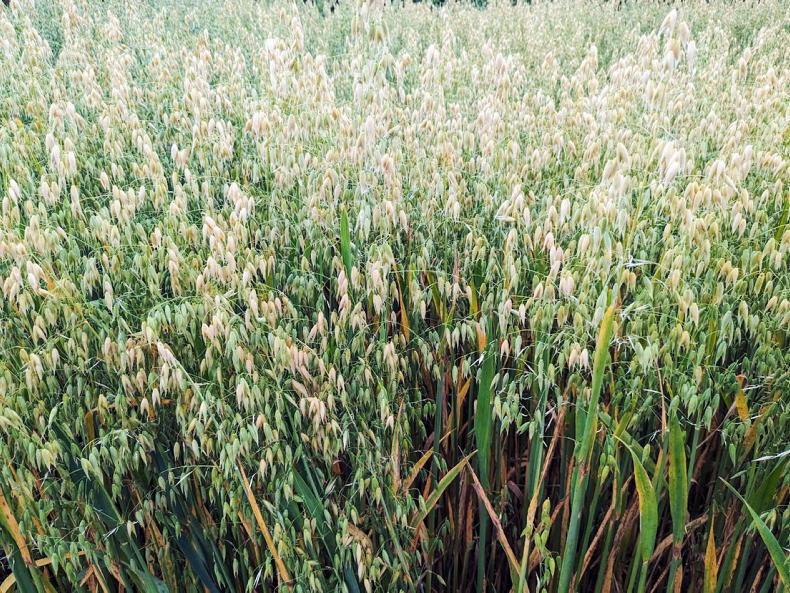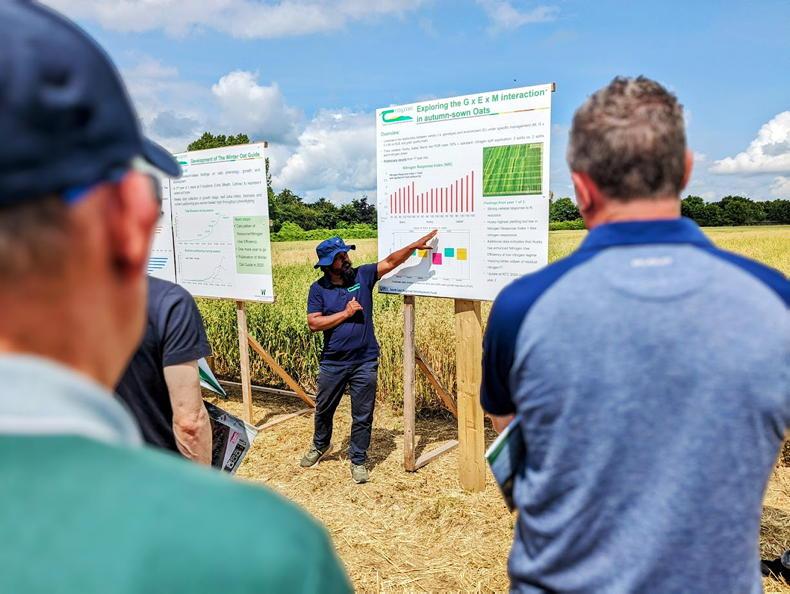Market price volatility and the lack of a premium price from processors have been revealed as the two primary challenges to growing oats on the island of Ireland, according to a new survey.
Speaking to large crowds at the Teagasc and Irish Farmers Journal Crops and Cover Crop Cultivations open day at Oak Park, Dr Atikur Rahman spoke of the challenges and benefits of growing oats in Ireland and how the Oats Ireland Forum is trying to identify research priorities to assist the oats sector in addressing future challenges.
The Oats Ireland Forum is a partnership between Teagasc, the Agri-Food and Biosciences Institute (AFBI) and stakeholders such as growers, industry representatives, researchers and agronomists across the island of Ireland, which was established in 2021.
Other challenges identified by this survey include concerns about grass weed issues, a lack of variety choice and the increased presence of oat mosaic virus.
Inconsistency
Grain yield and quality inconsistency plus a lack of agronomic-based information to support management practices were also seen as issues by farmers.
To combat this, work is under way to develop a winter oat guide, similar to the current winter wheat and spring barley guides.
Three sites (Cork, Meath and Carlow) on three different soil types are being monitored on a weekly basis over three years to determine oat phenology, growth and development patterns, and nutrient partitioning between leaves, stem and the panicle. The guide is expected to be published in 2025.
Preliminary results presented showed that there is a strong varietal response to nitrogen reduction, with the variety Husky performing strongly at low nitrogen rates compared with Isabel and Barra.
This means that Husky is less responsive to applied nitrogen, but has a greater nitrogen use efficiency at low nitrogen rates. However, more research is required on this, as it only represents one year of data.

There was a big focus on oats at the open day.
The Oats Ireland Forum survey also asked what motivated growers to plant oats. Results show that the majority of farmers grow oats to reduce their inputs, to use oats as a break crop, and because the crop performs well on their soils.
Other reasons
Other reasons given to grow oats include spreading the workload across the year, the resilience of oats in unfavourable conditions, specific bonus contracts, broad-leaf weed suppression and the Straw Incorporation Measure.
These survey results will provide strategic direction to oats-based research over the coming years. If you would like to find out more or partake in the Oats Ireland Forum, you can get in contact with oatsIreland@gmail.com.
Market price volatility and the lack of a premium price from processors have been revealed as the two primary challenges to growing oats on the island of Ireland, according to a new survey.
Speaking to large crowds at the Teagasc and Irish Farmers Journal Crops and Cover Crop Cultivations open day at Oak Park, Dr Atikur Rahman spoke of the challenges and benefits of growing oats in Ireland and how the Oats Ireland Forum is trying to identify research priorities to assist the oats sector in addressing future challenges.
The Oats Ireland Forum is a partnership between Teagasc, the Agri-Food and Biosciences Institute (AFBI) and stakeholders such as growers, industry representatives, researchers and agronomists across the island of Ireland, which was established in 2021.
Other challenges identified by this survey include concerns about grass weed issues, a lack of variety choice and the increased presence of oat mosaic virus.
Inconsistency
Grain yield and quality inconsistency plus a lack of agronomic-based information to support management practices were also seen as issues by farmers.
To combat this, work is under way to develop a winter oat guide, similar to the current winter wheat and spring barley guides.
Three sites (Cork, Meath and Carlow) on three different soil types are being monitored on a weekly basis over three years to determine oat phenology, growth and development patterns, and nutrient partitioning between leaves, stem and the panicle. The guide is expected to be published in 2025.
Preliminary results presented showed that there is a strong varietal response to nitrogen reduction, with the variety Husky performing strongly at low nitrogen rates compared with Isabel and Barra.
This means that Husky is less responsive to applied nitrogen, but has a greater nitrogen use efficiency at low nitrogen rates. However, more research is required on this, as it only represents one year of data.

There was a big focus on oats at the open day.
The Oats Ireland Forum survey also asked what motivated growers to plant oats. Results show that the majority of farmers grow oats to reduce their inputs, to use oats as a break crop, and because the crop performs well on their soils.
Other reasons
Other reasons given to grow oats include spreading the workload across the year, the resilience of oats in unfavourable conditions, specific bonus contracts, broad-leaf weed suppression and the Straw Incorporation Measure.
These survey results will provide strategic direction to oats-based research over the coming years. If you would like to find out more or partake in the Oats Ireland Forum, you can get in contact with oatsIreland@gmail.com.








 This is a subscriber-only article
This is a subscriber-only article










SHARING OPTIONS: